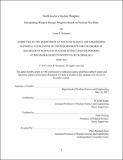| dc.contributor.advisor | R. Scott Kemp and Vipin Narang. | en_US |
| dc.contributor.author | Kenausis, Luisa R | en_US |
| dc.contributor.other | Massachusetts Institute of Technology. Department of Nuclear Science and Engineering. | en_US |
| dc.coverage.spatial | a-kn--- | en_US |
| dc.date.accessioned | 2017-12-05T16:24:56Z | |
| dc.date.available | 2017-12-05T16:24:56Z | |
| dc.date.copyright | 2017 | en_US |
| dc.date.issued | 2017 | en_US |
| dc.identifier.uri | http://hdl.handle.net/1721.1/112370 | |
| dc.description | Thesis: S.B., Massachusetts Institute of Technology, Department of Nuclear Science and Engineering, 2017. | en_US |
| dc.description | This electronic version was submitted by the student author. The certified thesis is available in the Institute Archives and Special Collections. | en_US |
| dc.description | Cataloged from student-submitted PDF version of thesis. | en_US |
| dc.description | Includes bibliographical references (pages 55-56). | en_US |
| dc.description.abstract | The proliferation of nuclear weapons is a significant global security issue, and it is important to carefully study the nuclear weapons programs of states that are actively engaging in nuclear proliferation. In this thesis, I interpret the seismic and radionuclide data from North Korea's first two nuclear tests in 2006 and 2009, emphasizing the limitations of that data in reaching deterministic conclusions about the precise devices tested by North Korea. I also review the seismological and radiological literatures surrounding a proposed North Korean nuclear test in May 2010, and summarize the process by which that proposal was investigated and rejected. The most recent North Korean nuclear tests, in 2013 and 2016, are reviewed only briefly. It is found here that the technical data available after the North Korean nuclear tests in 2006 and 2009 provide relatively little information about the designs of the devices that were tested. In the case of the 2009 test, the apparent containment of radioactive material from the test could indicate some improvements in the testing process relative to 2006. The explosive yield of North Korea's nuclear tests has generally increased over time, but this trend in yield does not provide clear information about the advances that have been made in the design of North Korean nuclear warheads. | en_US |
| dc.description.statementofresponsibility | by Luisa R. Kenausis. | en_US |
| dc.format.extent | 56 pages | en_US |
| dc.language.iso | eng | en_US |
| dc.publisher | Massachusetts Institute of Technology | en_US |
| dc.rights | MIT theses are protected by copyright. They may be viewed, downloaded, or printed from this source but further reproduction or distribution in any format is prohibited without written permission. | en_US |
| dc.rights.uri | http://dspace.mit.edu/handle/1721.1/7582 | en_US |
| dc.subject | Nuclear Science and Engineering. | en_US |
| dc.title | North Korea's nuclear weapons : interpreting weapon design progress based on nuclear test data | en_US |
| dc.title.alternative | Interpreting weapon design progress based on nuclear test data | en_US |
| dc.type | Thesis | en_US |
| dc.description.degree | S.B. | en_US |
| dc.contributor.department | Massachusetts Institute of Technology. Department of Nuclear Science and Engineering | |
| dc.identifier.oclc | 1011355155 | en_US |
